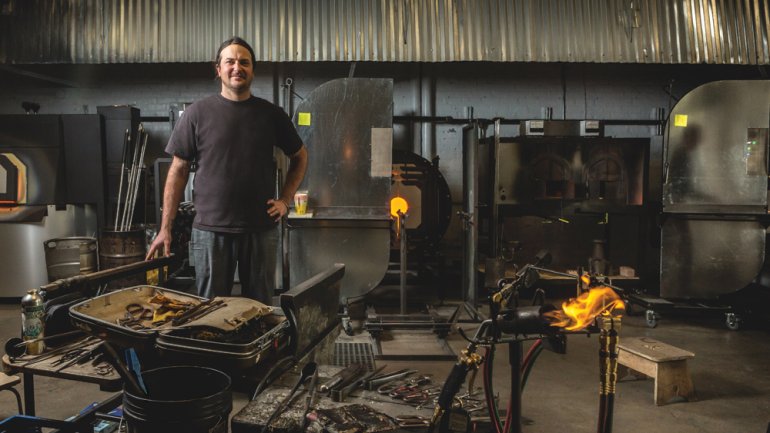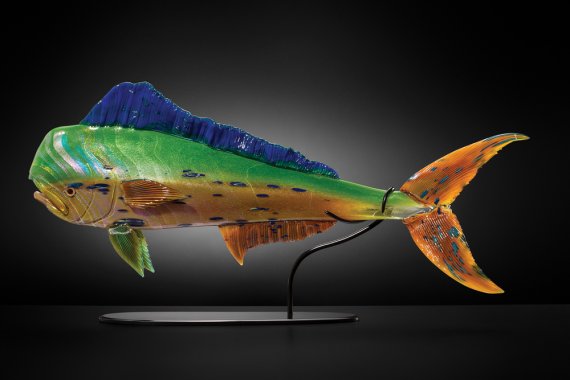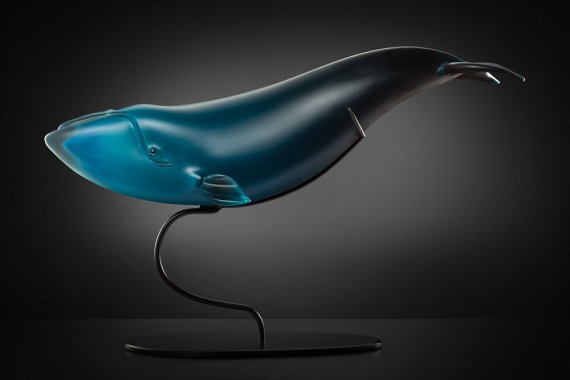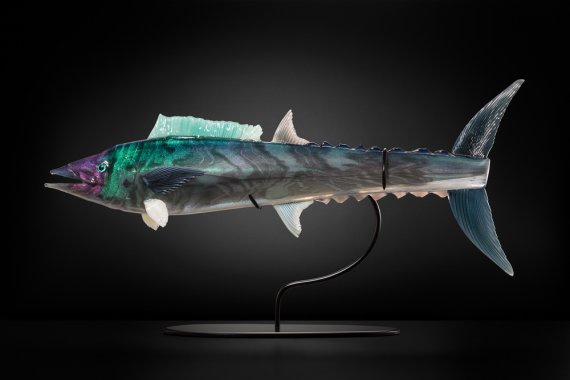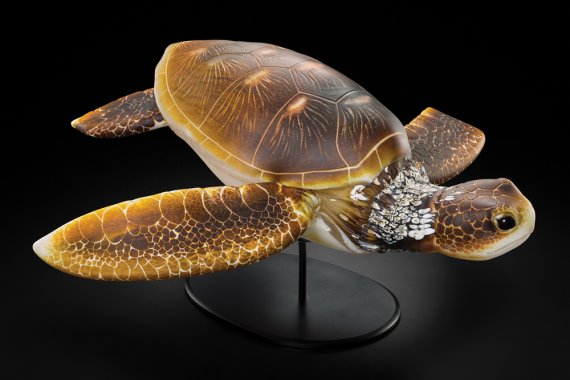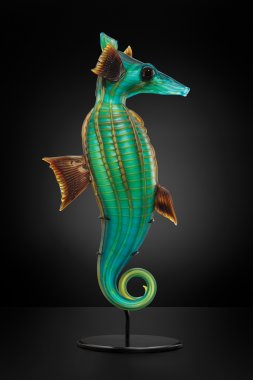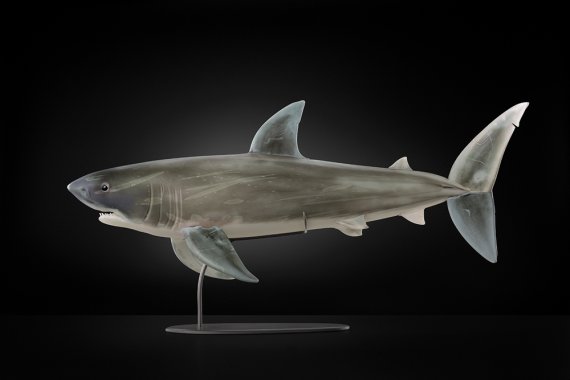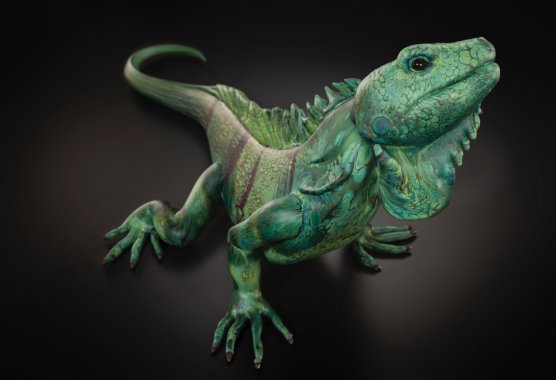Aqua Man
Aqua Man
Raven Skyriver grew up in the San Juan Islands off the coast of Washington, which he lovingly refers to as “a great place to ramble.” It’s a place of infinite adventure, teeming with marine life: sea turtles, otters, whales, and fish. Skyriver would sail and kayak with his family, exploring the water and the multitude of creatures that call it home. “When you have an encounter with a wild creature in a wild place, it’s always impactful and touching,” he says. “So those have always been things that were a strong influence on my life.”
Skyriver’s love for the natural world is matched by his passion for glass. His sculptures – which combine observational accuracy, impeccable technique, and a dash of magic – celebrate the world of water. His frogs and whales might have heightened hues, but they also portray the real creatures with a striking fidelity, visible in a gummy spread of toes or a long arc of underbelly.
His work has appeared in exhibitions across the United States, and he has taught at high-profile institutions such as Penland School of Crafts and the Corning Museum of Glass. As a high schooler learning the medium, though, he didn’t display a prodigy’s easy expertise. Studying under Lark Dalton, Skyriver found that his instant love of glassblowing wasn’t quite matched by technical proficiency. “My first couple pieces, as with most everyone who starts blowing glass, were just lumpy things that could kind of hold some water,” he says, laughing.
But Skyriver kept at it, studying Venetian-style glassblowing and, eventually, producing recognizable functional vessels. He didn’t realize the medium’s sculptural potential, however, until he began working with Karen Willenbrink-Johnsen at Pilchuck Glass School in 2003. He helped her with her own naturalistic animal sculptures and also assisted her when she was blowing glass for William Morris, whom Skyriver eventually worked for at Pilchuck.
The first sculptural piece Skyriver tried was a goldfish. “I hadn’t found my voice or anything,” he says. “I was just dabbling … I got to put some fins on it, which was fun.” Slowly, he expanded his repertoire. “I made some little betta fish, and I made a bunch of goldfish and some koi, just practicing technique and color application and trying to exercise some of those muscles, that technique that I was seeing every day working for Karen and working on Bill’s team.”
All that practice paid off. At 36, Skyriver creates work with a degree of mastery obvious even to those who know little of the demands of the medium. Anchor (2017), a 26-inch-tall seahorse, features precise ridges, eyes that seem to see, and fins so lifelike you expect them to start wriggling. Apex (2017), a translucent great white shark, bears battle scars up and down its hide, with teeth to deal out damage of its own. Throughout his portfolio, the level of detail stuns: a sea turtle’s shell curving to fit its upper back, a walrus’ back flippers folding up under its belly.
“The thing about marine life is there’s no end to the complexity and variety and all the different biodiversity that’s out there, from phytoplankton all the way up to the blue whale,” Skyriver says. That breadth brings an aesthetic gift as well as a technical puzzle. “I’ll pretty much always work from some sort of resource – a book, or I’ll rip something off the internet – and look at these two-dimensional images and coloration and texture and pattern, and then try to figure out how I can capture that in the glass.” Skyriver admits that trial and error looms large in his creative process, but “that challenge,” he says, “is the fun part.”
Although Skyriver’s resources are two-dimensional representations, his inspiration still comes from the living, breathing world around him. He has recently returned to his native Lopez Island to raise his own family; after living near Pilchuck school in the early 2000s – where he met his wife, fellow glass artist Kelly O’Dell – and in a cottage on William Morris’s property for a dozen years, Skyriver is glad to be back where he grew up and to be seeing the environment through the eyes of his 8-year-old son, Wren. “We try to get out as much as possible,” he says. “We go hiking, we go out on the water to pull up crab, and then we do trips too, to the mountains, to try to get out and go snowboarding or skiing and go hiking and camping.” For two of Wren’s birthdays, the family’s gone on 60-mile kayak trips.
Skyriver’s work may be a celebration first, but it also acts as a kind of warning, a reminder of what could be lost if we don’t protect the environment. “A lot of what I think about is where our food comes from,” he says, “our dependence on the ocean as a resource, and our inter dependence on something that I think we take for granted a lot and trash in a lot of ways.” While that message is mostly implicit in his current work, Skyriver doesn’t rule out addressing environmental issues head-on. “I think it’s a little harder sell, as far as the galleries are concerned,” he says, but adds that he’s interested in tackling such issues more directly in a museum show.
In the meantime, Skyriver will continue living in the space between his art and the world that inspires it. He and O’Dell recently completed a Kickstarter campaign to fund a new studio – “we’re super-grateful for all the support from the glass community and our collector base,” he says – which will allow them to grow deeper roots in the island that inspires them.
Skyriver envisions his studio serving as the kind of artistic community hub that helped him get his own start, and eagerly anticipates the collaborations the space will make possible. “I’m so looking forward to just geeking out,” he says, “trying different forms and challenging myself with all those different aspects of making.”
